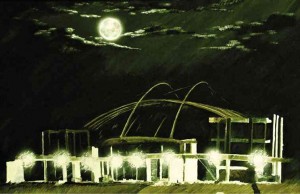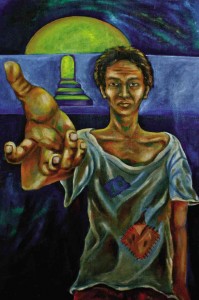
In the year after the end of the world (as the Mayan calendar supposedly alleged), life goes on with all its malaise and maladies.
An exhibit featuring visual artists from Tagum City makes sense of this continuing mess. By the artists’ willful act of creation, they disavow the forces of destruction and instead divine meaning, tell stories, offer hope, and embrace our common humanity.
In their depictions of the personal, as well as the political, the 13 artists featured in this exhibit under the curatorial wizardry of Nestor Horfilla cue us into the more significant and inevitable drama of the apocalypse we are all facing, as the clock ticks ever so quickly, if not quietly.
It is an aesthetic grounding in what the celebrated post-9/11 Polish poet Adam Zagajewski calls “the mutilated world.”
This context of impending, or recurring, disaster imbues the still lifes, landscapes, portraits, abstract works, and the other artworks a particular piquancy and potency.
Among the 13 artists, here are our favorites:

Ronald Joseph G. Arobas is an Electronics and Communication Engineering graduate and now works on the secretariat staff of the Bids and Awards Committee (BAC) of the City of Tagum Local Government Unit.
Influenced by his cousins who also had aptitude in drawing, Ronald started to produce colorful sketches of the Ninja Turtles at 5 years old.
In grade school he participated in several poster-making competitions, with pastel as his medium. Mr. Generalao, his elementary coach, encouraged him to proceed to painting. Joy Ramos, his high-school mentor in drafting, reinforced his desire to pursue his creative interests.
He does not remember exactly how many artworks he has done so far, but he treats all of them as major artworks.
Ronald explains his sense of aesthetic mission: His style does not merely document reality but also serves as a social critique of what he sees around him. “The Yellow Chair” juxtaposes the complex relationship of humility and fame.
“Tubig sa Pobre” is an impatient revelation of the anguish of the deprived.
“Koi” celebrates the quixotic but necessary quest for good fortune.
Ronald considers himself a moody artist who lingers in the timely moment that would spur him to create a masterpiece. He is nurtured by the paintings of other artists, particularly the works of the masters. His parents serve as his singular inspiration.
Focus on the simple
Ervin Jay P. Apsay began painting simple subjects in his grade-school days. In his inimitable way, he creates images of the world around him. He claims to have been inspired by everyone, especially members of his family.
Eyoy, as close friends call him, is a registered nurse who did not practice his profession. Instead, he nurses wounded spirits through his artworks.
He agrees he is more adept at realism, although he has delved into abstraction from time to time.
“I am a simple artist who tries to defamiliarize simplicity,” he says, describing his works as a “compelling narrative of my life’s journey.”
His thoughts on his subjects are poignant and straightforward: “My works focus on the simple, the ordinary or trite subjects observable in the social world. Most of the time, many people would disregard them or could not give due attention to them. Yet, despite being simple and ordinary, they carry great significance as they are related to our day-to-day life and have symbolic meanings that shed light on our existence.
“I like to depict ordinary folk who work hard, aspire for a better life, and contribute to the development of the city.
“I painted the market scene because, for me, it captures the particular dynamics of the city as a melting-pot where various ingredients and appetites and cultures interact to sustain both body and soul, for everyone, rich or poor alike. Likewise, my artwork gives value to the services of the market vendors. They form part of those who contribute to the victories gained in Tagum or Tagumpay ng Tagum…”
Confessional tone
Jonathan T. Sensano says he is influenced by his world: He gathers inspiration from himself and from everyone else.
He finished his Fine Arts degree at the Ford Academy of the Arts. The title of his thesis project had a self-confessional tone: “The Sinner.”
In that work, the disfigured body of a young man spurs contradicting emotions in the viewer. And the visual juxtaposition of gaudy and laid-back colors is so provocative that the viewer would suspend quick judgment on its significance. The surrealist piece is not only stunning; indeed, it is also a milestone in Jonathan’s creative journey.
Imbibing a strong passion to draw since high school, Jonathan is becoming one of Tagum’s prolific artists. He has produced countless admirable artworks—from small sketches of still life, to portraits, to eye-catching murals and other figurative works that cross the border between impressionism and abstraction.
While most of his past works display a “Western orientation,” Jonathan is on the path of reinventing his Asian rootedness and absorbing his Japinoy identity.
One can find a diverse collection of artworks hung on the walls of his home-studio, which he does not even care to count—he merely paints and displays them.
He is wary about defining his aesthetics. “I just embrace satisfaction in doing art,” he says.
For him, there is nothing that could fittingly describe him as an artist. “Look at my works, then you know me,” is all he would say.
Art as play
Peachy Calvento started drawing at 3 years old, but her first painting was accomplished when she was 8.
She discloses she grew up with art.
“I did not consciously develop it until I reached high school,” she admits. “That was the time when I decided, ‘Art is who I am.’ That was also the time when I started art research.”
Her wisdom and passion in art are captured in what she wrote about her life in the arts: “Art started as a form of play for me. To keep me behaved when I was a toddler, my mama gave me colored chalks; I busied myself dirtying our walls. As far as I could remember, my influence in art was Stan Lee of Marvel Comics, and my first art-master influences were Claude Monet and Norman Rockwell.
“During my early years, it’s the dogma of Impressionism that I strictly followed—to paint what is beautiful. These days, I’m embraced by commercialism. I paint according to the demand of my client. This is the main reason why I decided to master different styles.
“Like I said, I’m a commercial artist. I consider all my works, as well as the commissioned ones, major. I have sold more than 20 pieces and did commissioned work for about the same number. Some are still unsold. A ‘major work’ for me is an art that I created with months of preparation and months of execution. I highly practice perfection.”
Peachy’s style, as she describes it, is “impressionism-landscape, a particular style that lives in a concept of painting from nature, or what you see is what you get.”
As an artist, Peachy is “secluded, detached, and simple.”
She says: “I define my art, my outputs and creations. The way I clothe myself doesn’t define me as an artist.”
Prospering in art
Angelo M. Chu is an architect, a businessman, and a very unassuming artist with extensive engagements in the business of art.
Like most artists, he started drawing in grade school. But Angelo did not only sustain his craft, he also prospered in the trade of art materials and in framing artworks.
He recalls that his peers encouraged him to paint. And his fondness for the beauty of nature is evident in his collection of still lifes. Angelo says he was greatly inspired by his “ninong sa kasal,” an architect who has chosen to be a full-time visual artist.
For Angelo, the creative process is an expression of freedom and each output is a source of fulfillment. His style is minimalist yet brilliantly naturalist.
His advice to other artists: “What is most important in creating art is originality. The artist is the sole creator of the art piece. Well, you can copy a picture, but never copy a painting.”
Solace in painting
At age 83, Catalina Y. Cosio is independent, an activist, and a certified environmentalist who condemns the indiscriminate abuse of the country’s natural resources.
She started drawing and sketching when she was a child. When her family migrated to Magugpo, she found it difficult at first to adjust to the new environment and the locals.
So she found solace in painting. She bought oil paints and brushes and assembled a few canvases. It took her three paintings before she was able to adjust to her new environment.
Eventually she was preoccupied with a lot of things. But she admits she did not abandon her passion to paint.
When her husband passed away, she buried herself in art “as a creative outlet of my emotions.”
At the height of martial law, another Mindanaoan artist and activist, Bert Monterona, encouraged Mommy Cosio to continue painting, even to open a gallery.
She recalls Bert’s advise: “Mommy, sa art, hindi ito tungkol sa pangit o sa maganda. Ang importante, iyong sa ’yo, may sarili kang ‘stroke’ at originality.”
Though hesitant at first, she plunged into the thrill of creating more art. “As my profound expression, I paint whatever I consider beautiful,” she says.
A number of her major works are in the United States. She believes that “art is a work of conscience.”
Mommy Cosio’s first one-woman show in March 2010 was a hit among art enthusiasts, including dignitaries and prominent names in the various fields of art.

